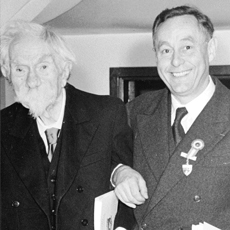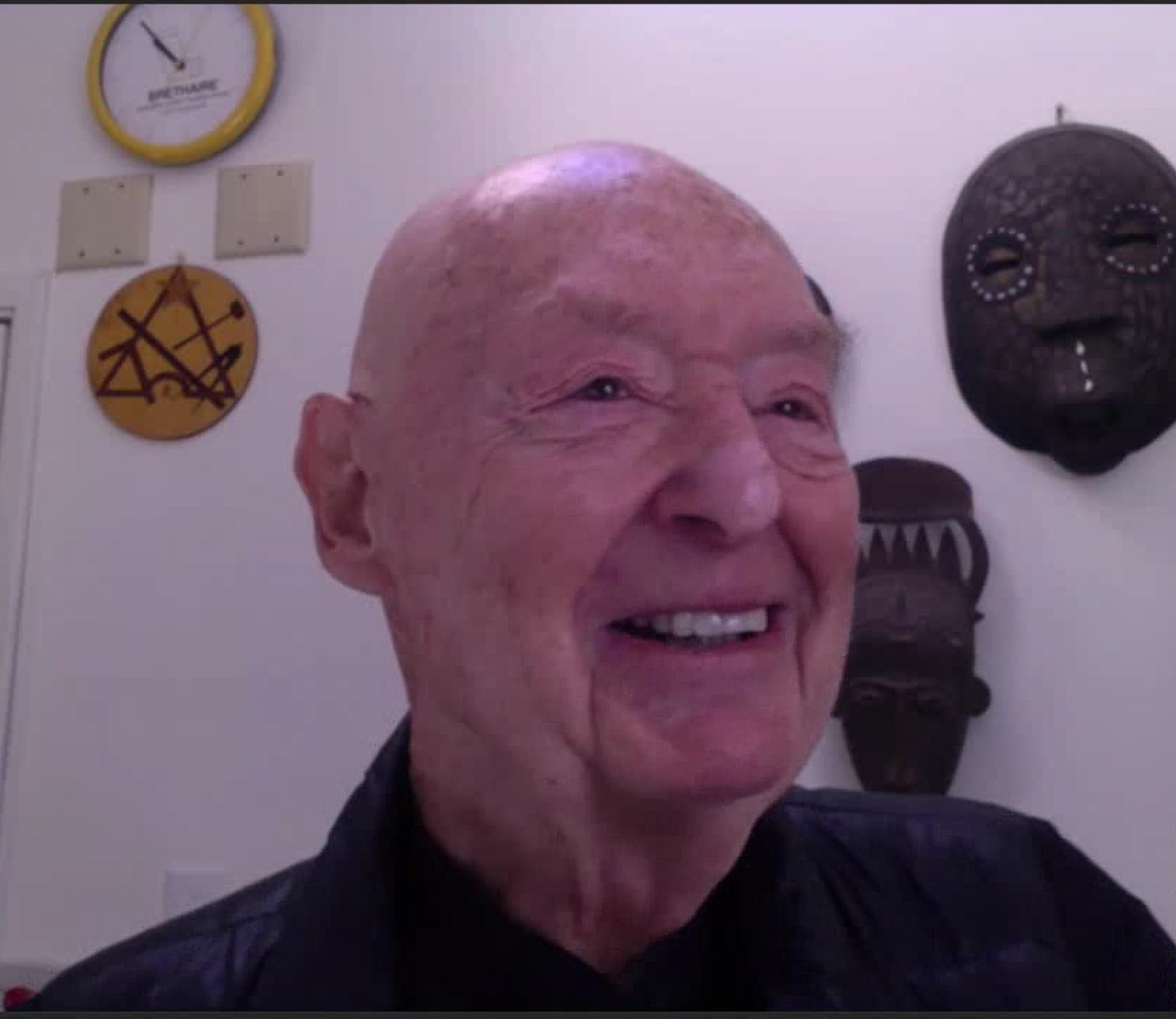 Dr. Bernard Halpern & Professor P. Portier, co-discoverer of anaphylaxis, at the 1958 International Association of Allergology meeting in Paris.
Dr. Bernard Halpern & Professor P. Portier, co-discoverer of anaphylaxis, at the 1958 International Association of Allergology meeting in Paris.
In 1942, phenbenzamine (Antergan), the first antihistamine usable in humans was discovered by famous French allergist Bernard Halpern, MD, who then went on to introduce promethazine (Phenergan), still the most potent of that class, in 1947. It was the first gigantic breakthrough in treatment options for allergy. The College, founded in 1942, then known as the American College of Allergists, had already held its fourth Annual Meeting at the time of Dr. Halpern’s discovery. Hal M. Davison, MD, FACAAI, was president of the nascent organization which was enjoying a steadily growing membership.
Dr. Bernard Halpern was well-known in France, but less-so in the U.S. His son, allergist Georges Halpern, MD, PhD, recently shared his father’s dramatic story for this article. So what does Dr. Bernard Halpern have to do with the College and our Annual Meeting? Read on – it’s all part of our rich history.
With his ground-breaking contributions to medicine and science, Dr. Bernard Halpern became a frequently invited lecturer in the U.S. Beginning in 1947. Dr. Bernard Halpern, together with his colleague Jean Hamburger, MD (one of the great pioneers in nephrology and kidney transplantation), expanded their academic activities to the organization of international allergy meetings. Dr. Halpern was a close friend of College member M. Murray Peshkin, MD, FACAAI, who was College president during this time. He decided to start collaborating with the College. “He liked that the College put patients first – they provided doctors with the information they needed to educate them and to treat patients,” said Dr. Georges Halpern.
In 1974, the College held its first and only international Annual Scientific Meeting in Paris, shepherded largely by Dr. Bernard Halpern who was a keynote speaker. Dr. Georges Halpern was speaking as well, and presented an abstract on the clinical significance of serum IgE determination. The newly opened Paris Convention hosted the College as its first medical convention, and the program included both education and scientific sessions as well as social events with a Parisian flair. “Bernard Berman, MD, FACAAI, our president-elect and overall program chairman [at this time], has assembled a veritable “Who’s who” of the foremost clinicians and research workers in allergy, and their European counterparts. It will easily be one of the most impressive scientific symposia and conferences in allergy ever held anywhere,” wrote then-President Wm. Sawyer Eisenstadt, MD, FACAAI, in the program guide. Meeting attendees were treated to a special fashion show featuring a famous couturier of Paris. Excursions to Champs Elysees, Grand and Petit Palais, Invalides and Napoelon’s Tomb, the Eiffel Tower, the Arc de Triomphe, and Versailles were planned for attendees as well. The cost to register? Anywhere from $640 to $780, all hotel and airfare included!
During that meeting, Dr. Berman, Howard Rappaport, MD, FACAAI, past president, and Joseph Bellanti, MD, FACAAI, College historian and past president, visited with Dr. Bernard Halpern at his home. Dr. Georges Halpern, an internationally renowned French chef, treated the group to unique French cuisine with wine and champagne. “We talked about science and had a wonderful dinner,” recalled Dr. Bellanti. “Dr. Bernard Halpern was a very nice man – very kind, very brilliant, who shared his research and discoveries with us, especially his immunotherapy of malignant disease. I was privileged to meet this great scientist who was a genuine friend of the College.” Dr. Georges Halpern remembers hosting these College leaders. “I helped organize their visit to Paris, and I served as ambassador for this international meeting. We all have lots of good memories together,” recalled Dr. Georges Halpern.
At the meeting in Paris, Dr. Eisenstadt and Dr. Berman awarded Dr. Bellanti with an exceptional and singular accolade of the College, The Humanitarian Award for Excellence in Teaching of Clinical Immunology, a recognition Dr. Bellanti treasures above all others he has received. “As you can tell, Dr. Bellanti was flying high in the allergy and immunology world when I was still in high school,” remarked Bobby Lanier, MD, FACAAI. “He is so well-known and respected internationally. He travels in a different plane of existence!”
Dr. Bernard Halpern’s Life and Accomplishments
Dr. Bernard Halpern’s life is fascinating – he crosses paths with dozens of internationally well-known names from history and medicine. Born in 1904 in the then-Russian Empire, now Ukraine, his family was often on the move, trying to find a safe space to live. At the age of 16, he jumped on a German prisoner train alone, and made his way to Poland where he finished his secondary education. His father declared him dead. Things weren’t much easier for him in Poland, so he escaped with some friends by jumping on trains to Nancy, France. In 1928, he jumped cargo trains until he made it to Paris. He wanted to attend medical school at the Faculty of Medicine at the University of Paris – but he had nowhere to stay, and no means to even pay for food. A kind woman at the university gave him a job as a lab assistant, which allowed him to attended lectures while working. He completed his thesis on viper venom and demonstrated its mode of action by histamine release – sparking his interest in the field of allergy. In 1937, Daniele Bovet, MD, synthesized the first antihistamine ever – which worked great in animals, but was too toxic for humans. Dr. Bernard Halpern knew Dr. Bovet through their mutual interest in the specialty and recommended to him other molecules to investigate that wouldn’t be so toxic. The results of their subsequent collaborative studies were published in a seminal paper by Corneille Heymans, MD, a recipient of the Nobel Prize.
With France divided between the Nazi-collaborative Vichy regime and the Free French de Gaulle government in exile, Dr. Bernard Halpern had to move frequently to find refuge. Eventually, he found a haven in the laboratories of Rhone-Poulenc in Lyon, where he could work steadily on testing phenbenzamine. He discovered it could also preserve blood – an important discovery during the war when Germany as actively fighting on the Russian front and the need for blood was critical. His discovery attracted the attention of Hitler himself, who asked him to come work for him. “I need to think about it,” replied Dr. Bernard Halpern. He was cautioned to not take too long to decide. On the morning of Dec. 21, 1942, Dr. Bernard Halpern rushed home with his wife and announced to his two children, aged five and six, that they were leaving immediately. Dr. Georges Halpern remembers this vividly – the only thing he grabbed to bring with him was a French dictionary that he needed to study for school. The family found help crossing the border to Switzerland, where they were placed in a former cemetery surrounded by electrified razor wire. Dr. Bernard Halpern was taken away to labor to “pay” for their stay. He joined the French underground resistance and in 1944, participated in the fight for the liberation of Paris. Later, the family returned to their apartment in Paris. “That’s when I discovered that my father was very resilient, very honest – he had a love for social justice,” recalled Dr. Georges Halpern. It was a difficult time for the family, and Dr. Georges Halpern was emotional as he reflected on those days. “It was very good for my future,” he said, “because now I know that I can survive a war.”
 Dr. Georges Halpern
Dr. Georges Halpern
In 1947, Dr. Bernard Halpern’s research on promethazine was complete – and it was ready to be used in treating severe allergic conditions in people. Promethazine is still in use today as a powerful anti-emetic. From there, he began to research other drugs and derivatives, which eventually led to his discovery of Thorazine, the first pharmacologic agent for the treatment of schizophrenia. He had crossed paths with Jean Hamburger, MD, who is credited with creating the field of nephrology and pioneering one of the first kidney transplants in 1952. Their talks about ideas for organ transplantation eventually led to Dr. Bernard Halpern and Dr. Georges Halpern manufacturing the anti-lymphocyte serum for Christiaan Barnard, MD, for his first two heart transplants. As time went on, Dr. Bernard Halpern’s interests shifted to using the body’s own immune system to treat cancer. He was the first to use immunotherapy to treat acute leukemia in children.
Many thanks to Dr. Georges Halpern for sharing his father’s story with the College, and to College Historian Dr. Bellanti, for his editorial assistance in the preparation of this article.
Got a great memory of College leaders or past allergy and asthma treatments? Share it with us!